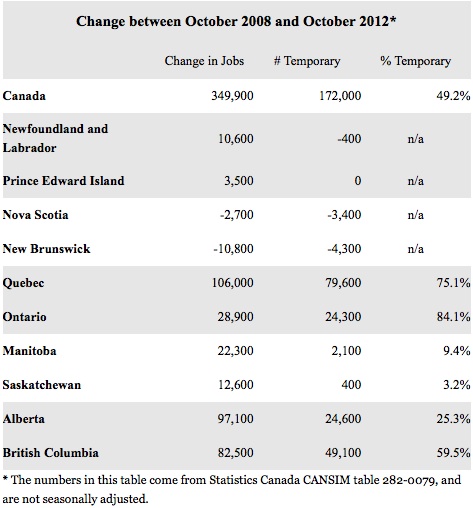Every time this government crows about its job creation record, I cringe. They have moved the finish line and declared victory. No reason to worry about the unemployed here, folks. Let’s move on to more public service cuts, and/or tax cuts.
Never mind that unemployment has been in and around 7.4 per cent since the spring of 2011, nowhere near the 6 per cent prior to the recession. Never mind that there were nearly 300,000 more Canadians looking for work in October 2012 than there were in October 2008. So let’s take a look at some of those claims.
1. “We’ve created over 800,000 jobs.”
The number of jobs created depends when you start counting. The pre-recession peak was October 2008, and the trough was July 2009. If you compare our situation to before the recession, there are 390,000 more Canadians employed, but there are also nearly 300,000 more Canadians unemployed.
A good way to gauge if we have created *enough* jobs is to look at the employment rate — the percentage of working age Canadians employed. In October 2008, 63.5 per cent of Canadians were employed. This number has been at or below 62 per cent since February 2009.
2. “90 per cent of the jobs created have been full-time.”
That’s true (if you measure from July 2009), and usually a reasonable measure of a good job. But if we look at the new jobs created since October 2008, almost half (49 per cent) were temporary jobs. Only 13 per cent of all Canadian jobs are temporary, so this is clearly a disproportionate increase in temporary employment. Temporary jobs pay less, and are, well, temporary. Oh, and if you’re hoping to qualify for unemployment insurance, you’re less likely to have banked enough hours by the time your contract runs out.
As you can see in the table above, Quebec, Ontario, and B.C. all created a higher proportion of temporary work than the national average.
3. “The majority of job creation has been in traditionally high paid sectors.”
Armine covered this here, showing that new hires are now being paid 40 per cent less than the average worker in their sector. I’d like to add that the average weekly earnings of temporary workers are only 65 per cent of the average for permanent workers, so the growth in temporary work comes into play here as well.
The point?
If you look at Canadian labour market indicators carefully, as the PBO did recently, you see that there is still slack in the labour market, there is still room for fiscal stimulus. You see that there is still a need for extended EI benefits, and there is a huge need for public infrastructure investment. The Harper Government’s New Math aside, there is no room for any more *fiscal consolidation* (in other words, austerity).



